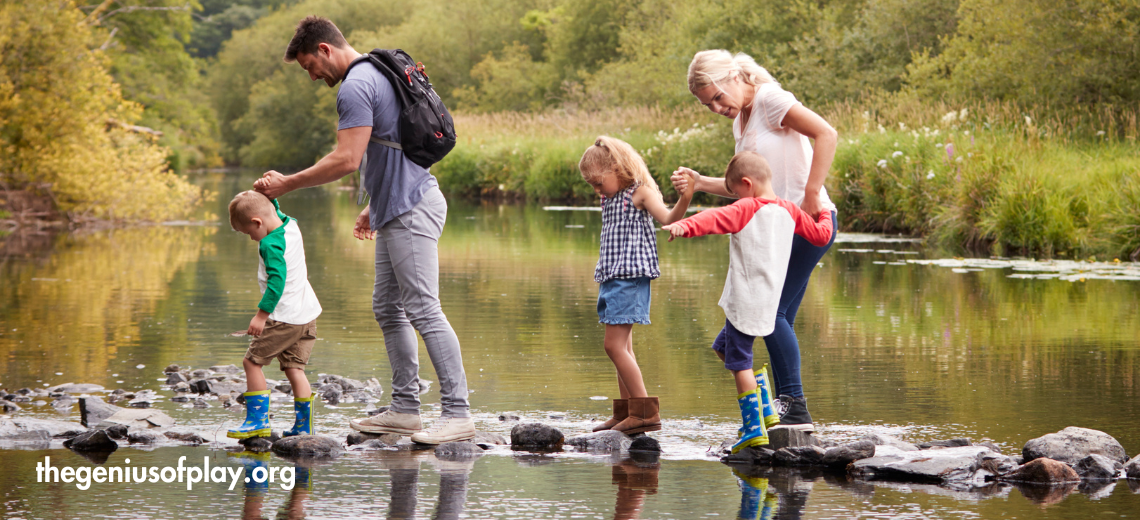Movement Play Enhances Learning in a Big Way
Imagine a child outside wildly running through a field and coming across a wide stream. Having never crossed a stream before, she hesitates. She looks around and observes a single tree, with branches too small to be of any help. She tests her foot on two mossy rocks that provide a path but do not extend far enough to complete the crossing. She slips a bit on the moss. Looking through the tall grass near the edge of the stream she finds a rope, to which she might tie a heavy object. She finds a piece of discarded machinery that is heavy enough to serve as an anchor. After tying the rope to the anchor, she attempts to throw it across to the other side. The wind picks up and her throws fall short. Dragging it back after several attempts is tiring and the wind is getting stronger. She spots a pile of concrete nearby and decides to create a stepping stone path across the water, free of the risks of slippery moss. Once she throws the concrete, some pieces partially submerge to the extent that she’ll have to plan how to hop from two feet to one during the crossing. She takes a deep breath and makes the crossing, strategically moving from piece to piece.
Exploration is the act of traveling in or through an unfamiliar area to learn about it. Doing so encourages experimentation, looking at something from a new angle and trying to imagine how to address it. This happens through testing, creativity, and improvisation, with the outcome being adaptation to a new and novel situation. In turn successive adaptations to new situations build competence and confidence.
Experiences that enhance the ability to explore and experiment increase our adaptation. Without these experiences, hesitation when dealing with new situations can incite inaction so debilitating that it is now a common cause of depression in our youth. In fact, in 2024 the problem is so prevalent that we are now hearing about employers who must test potential hires for their ability to improvise and problem-solve as a basic first screening.
It is becoming well-known that our children are no longer playing indoors or outdoors with the frequency of past generations. As a Youth Fitness Coach, deeply invested in movement alongside the myriad benefits of play, (what I like to call Movement Play), I have seen a decline in a multitude of “assumed” movements and patterns over the course of more than 25 years.
Lack of movement experience, much less explorative playful movement has deprived a generation of movement options and capabilities.
More specifically, lack of self-directed free play that: encourages and allows for freedom from time constraints, is inherently attractive, and done for no reason, has diminished such that the ability to improvise and adapt in young adults has all but disappeared along with it. Consequently, risk recognition, assessment, and management development along with resilience have been similarly reduced. Together these variables are muting a generation’s potential in both physical and mental development.
Here are a few activities that can help parents encourage free play, exploration, experimentation, and risk recognition for young children:
Outdoor walks or hiking in general are rich in possibilities.
The benefits of being outside multiply the opportunities for positive outcomes in learning and mental health. Encourage the following (movements noted are for parents understanding, avoid prompting)
- Traverse a log (crawl, skip, walk) or any way over, (hurdle, climb, jump, step up)
- Move through a ditch any way across (hop, long jump, sidestep, roll)
- Make a water crossing
Making up sports-style play with no rules and no scoring.
Play with odd implements on unique surfaces.
- Use a stick to bat, golf or push a foil ball and play on an uneven surface.
- Get a balloon into a bucket 10x before opponent gets it in 10x.
- “Ping Pong Volley Soccer” combined basic structure, just get the ball back to the opposing player(s)
- Give kids chalk and have them draw any type of line. Then ask them to move along it however they want.
Movement Play Indoors:
- Laundry Baskets – create 3-5 different solutions to pull or push a distance in any way and then climb or get over the baskets in any way.
- Couch Cushions – hurdle over cushions in any way, then build a fort that everyone can move through.
- Bed Pillows – stack 2 or 3, and then crawl, jump, or hop on to the stack, until someone yells “throw pillow!” and players race to throw pillows at each other.
- Make up your own jumping or balance play.
In all cases, use your collective imagination to expand upon the opportunity to move while exploring and experimenting without the stress of restrictions as much as possible.
(1.) Oxford Languages Dictionary
(2.) Gray, P. (2011). The decline of play and the rise of psychopathology in children and adolescents. American Journal of Play, 3(4), 443–463. Peter Gray TED Talk https://www.youtube.com/watch?v=Bg-GEzM7iTk
and
(3.) https://corporateinnovation.mit.edu/2021/03/25/5051/
(4.) https://activeforlife.com/childrens-anxiety-and-the-decline-of-play/
and https://www.thegeniusofplay.org/genius/expert-advice/articles/the-decline-of-unstructured-play.aspx
(5.) Brussoni M, Olsen LL, Pike I, Sleet DA. Risky play and children’s safety: balancing priorities for optimal child development. Int J Environ Res Public Health. 2012 Aug 30;9(9):3134-48. doi: 10.3390/ijerph9093134. PMID: 23202675; PMCID: PMC3499858.
(6.) Pope, J., Egan, S. M., & Hilliard, E. (2021). The great outdoors: A bioecological systems approach to outdoor play. In A. Leavy & M. Nohilly (Eds.), Perspectiveson childhood (pp. 243–260). Cambridge Scholars Publishing.

